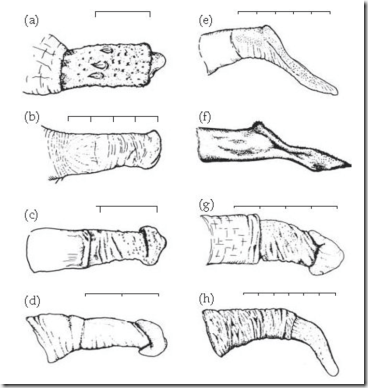L'uomo è monogamo per natura?
Difficile stabilirlo, guardando tra le scimmie più simili a noi troviamo di tutto…
... Primates exhibit all sorts of mating behaviour, including monogamous, polygynous — where males have multiple mates — and multimale-multifemale. One indicator of which behaviour occurs in a species is the size difference between males and females. The greater this sexual dimorphism, the more likely the mating is either polygynous or multi-male to multi-female. This can be shown by observing chimpanzees and gorillas, our closest living relatives....
Sappiamo però che la nostra fisicità puo’ dirci molto sul nostro sistema di accoppiamento, specie se consideriamo la dimensione dei genitali e il dimorfismo sessuale (differenza dimensionale tra maschio e femmina).
Partiamo col primo elemento: l’uomo sembrerebbe avere un pene grande e testicoli minuti…
… Humans have a much longer and wider penis than the other great apes. Even the largest of gorillas, more than twice as heavy as a human, will have a penis just two and half inches long when erect… However our testicles are rather small. A chimpanzee’s testes weigh more than a third of its brain while ours weigh in at less than 3%…
I testicoli piccoli depongono contro una nostra presunta sessualità promiscua poiché la scarsa produzione di sperma indica la poca “concorrenza in utero”. Il caso dei gorilla è simile al nostro…
… Male gorilla are also much larger than females, but they have a polygynous or harem-style mating system where many females live with a single male. With little or no competition actually inside the uterus, gorillas have had no need for a testicular arms race to facilitate the production of more and more sperm…
Il caso degli scimpanzé è invece opposto…
… Essentially, male chimps have sex all the time with any female and with any excuse. A female therefore may contain sperm from multiple partners at any one time, which puts the sperm itself – and not just the animals that produce it – into direct competition. For this reason, chimpanzees have evolved huge testicles in order to produce massive amounts of sperm, multiple times a day….
Tuttavia, il pene dell’uomo è di dimensioni ragguardevoli solo se comparato con quello dei primati a noi più vicini ma cessa di essere tale se allarghiamo lo spettro dei confronti alle altre scimmie…
… The human penis is large when compared with those of our closest relatives: chimpanzees, gorillas, and orangutans. However, primatologist Alan Dixson in his wonderfully detailed book, Primate Sexuality, suggests that if we look at all primates, including monkeys, this is just wishful thinking…. Comparative measurements show the human penis is not exceptionally long….
Ma cosa ci puo’ dire la dimensione del pene circa la nostra sessualità? Poco o nulla, cio’ che conta sono altri fattori: di solito le scimmie a sessualità frequente e promiscua hanno un pene complesso, “fantasioso” e variegato (creste, grumi, fronde, curve…), quello dell’uomo invece è tristemente uniforme e semplice, sembra fabbricato in serie… il che è tipico della scimmia monogama…
… The human penis is in fact extremely dull — it does not have lumps, ridges, flanges, kinks or any other exciting feature that other primates have. In primates, this lack of penis complexity is usually found in monogamous species….
Il dimorfismo sessuale (maschio più grande della femmina) è tipico poi delle scimmie poligamiche, e nell’uomo questo dimorfismo si presenta in modo accentuato. In effetti la poligamia, ancora oggi, è il regime familiare più diffuso nella cultura umana…
… Anthropologists Clellan Ford and Frank Beach in their book Patterns of Sexual Behaviour suggested that 84% of the 185 human cultures they had data on engaged in polygyny….
Qui bisogna fare una precisazione importante: quanto detto è compatibile con la constatazione che la maggior parte degli uomini sia comunque monogama di fatto. Infatti, anche laddove la poligamia è ammessa dal diritto, pochi possono permettersela nei fatti.
***
Veniamo ora le tre teorie principali che spiegano la monogamia duratura…
… First is the need for long-term parental care and teaching, as our children take a long time to mature. Second, males need to guard their female from other males. Third, our children are vulnerable for a long time and infanticide could be a risk from other males. So to ensure that children are able to reach maturity the male is likely to stay to protect them, both socially and physically. This may be why males have maintained their larger relative size….
Il cuccioli d’uomo, in effetti, è vulnerabile a lungo e richiede un’educazione prolungata, inoltre il dubbio sulla paternità è estremamente costoso nelle nostra cultura (specie dopo la rivoluzione agricole). Infine, tranne casi eccezionale, è difficile che un uomo possa permettersi di estendere il suo prolungato sforzo di protezione e cura su molte femmine.
Possiamo concludere formulando la tesi meglio supportata da queste osservazioni: l’uomo è poligamo quando puo’ permetterselo e monogamo di fatto nella stragrande maggioranza dei casi.
Ma dei dubbi restano: prima della rivoluzione agricola – gran parte della nostra “natura” si è formato in quell’epoca - non esistevano patrimoni accumulati dai singoli (eravamo nomadi!) e talenti molto differenziati, l’uomo viveva in bande di cacciatori/raccoglitori che mettevano tutto in comune, anche la prole in un certo senso era “in comune” (il gruppo delle femmine era molto coeso e operava insieme), il che diminuiva radicalmente i costi che scaturivano dai dubbi intorno alla paternità.
***
Le citazioni sono tratte da Mark Maslin: “Why Did Humans Evolve Big Penises But Small Testicles?”
